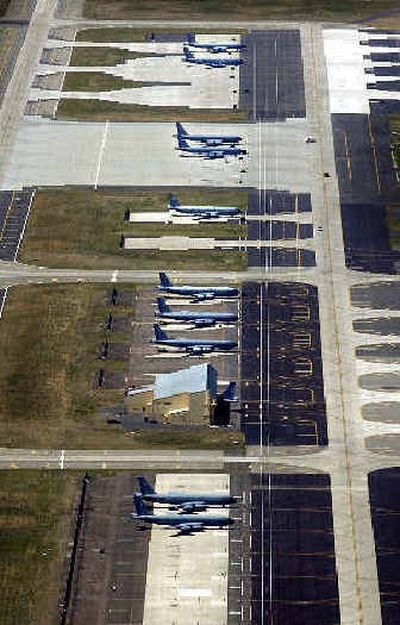Defense shields on full power to save Fairchild from budget ax

As the process that will lead to the closure of many military bases around the country enters its final approach, Spokane officials are wrapping up work they hope will land new missions at Fairchild Air Force Base.
They remain optimistic the West Plains post will retain its tanker squadrons, survival school and other functions, and perhaps receive more that will be reassigned from bases to be shuttered. Still, they are not letting down their guard.
More tankers, more training, perhaps restoration of some of the bomber missions Fairchild lost in 1994 are among the potential objectives — if indeed Fairchild passes muster. Even while the process unfolds, local officials are lobbying for a $12.8 million Mission Support Complex, $2.5 million to help fund the rerouting of the Geiger railroad spur, and $280,000 to link base and Veterans Administration medical facilities into the network that allows area hospitals and doctors to share patient information.
The Base Realignment and Closure Commission will announce May 16 which of 400-odd domestic military facilities will be closed for budget reasons. As many as 24 Air Force bases could be on that list, which goes to the President for review, then Congress for an up or down vote. Lawmakers cannot make any changes to the list.
This is the fifth go-round for the BRAC process, which has so far led to the closure of 97 bases in the United States and 55 major realignments. By one estimate, the changes had cut $16 billion in costs by 2002, with ongoing annual savings of another $6 billion.
Great for taxpayers, hard on communities that lose a major employer. Fairchild, with a payroll of about 5,000, is not only Spokane’s largest employer, but the source of roughly $1 billion in economic activity. Although community officials have always supported base operations, efforts have been doubled since the Pentagon announced its criteria for measuring the value of each base. With President Bush expected to name the final members of the BRAC commission this week, members and staff will start checking off which bases are up to snuff, and which are not.
To help make Fairchild’s case, the Spokane Regional Chamber of Commerce Forward Fairchild team has just finished a 67-page brief, “Global Reach, Readiness and Vigilance.” Chamber President Rich Hadley was in Washington, D.C., a week ago to distribute copies to senators Patty Murray and Maria Cantwell, Rep. Cathy McMorris, who sits on the U.S. House of Representatives’ Armed Services Committee, and other key lawmakers. Additional visits are scheduled into May, but Hadley says the work done the last year merely caps efforts under way since the first 1,400 acres for what has become Fairchild were purchased by the community in 1941.
Ultimately, Hadley says, all the hours of work, the travel, and the lobbying will be effective only because Spokane has consistently supported Fairchild. Communities that show interest in local military facilities only when more closures are pending don’t fool anybody. When development starts to encroach on base perimeters and neighbors start grousing about noise or smell or whatever, that information gets back to the Pentagon.
The Chamber, Hadley notes, testified against a proposed West Plains housing development because of concerns about potential noise complaints.
Fortunately, many of the generals and colonels rotated through Fairchild as they progressed up the chain of command have fond recollections of their time in Spokane. Last week, for example, the Forward Fairchild team received a briefing on tanker deployment from Col. Scott Wuesthoff, deputy director for Plans and Programs for the Air Force Global Military Division. Wuesthoff did two tours at Fairchild.
Sometimes, even painful impressions help. Hadley recalls two comments Air Force Gen. John Handy had regarding Fairchild’s rugged survival school:
“The first thing he said was ‘I went through it and I hate the place,’” recalls Hadley. “The second thing he said was ‘We can’t replace it.’”
That, he adds, will be the bottom line for the Air Force and other services.
“It’s all about military value,” Hadley says. The community can do its best to summarize that value from a civilian point of view. The view from the Pentagon is the one that counts. States, including Washington, are spending heavily to keep their bases in the field of vision.
All have a mission. Although some analysts wax optimistically about other potential uses for abandoned bases, Hadley says that has not yet happened.
Decommissioning a base can take years, he says. All personnel and equipment must be removed. Ownership issues must be resolved, and demolition and environmental remediation completed. New industry or other users would have to be recruited.
“It takes a long time,” Hadley says. “I don’t think we want to go through that.”